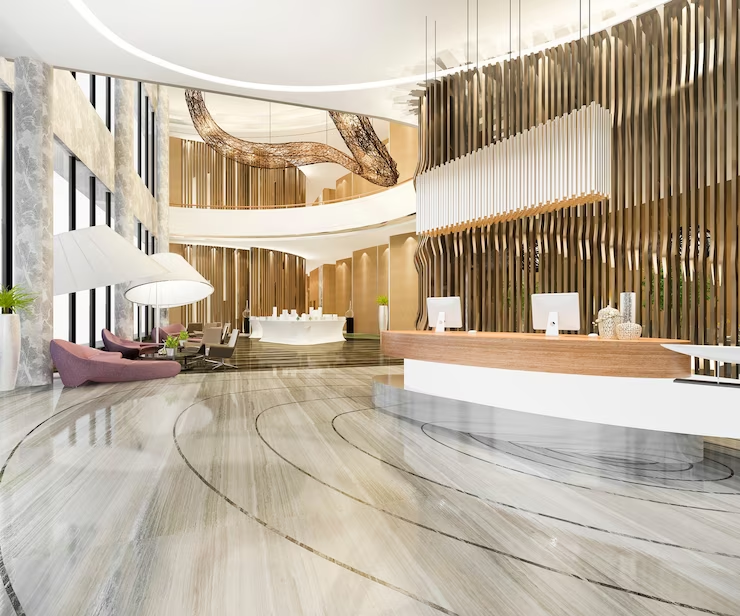In a world where every detail matters, luxury interior design stands as a testament to exquisite elegance and meticulous craftsmanship. For those who cherish beauty and sophistication, the allure of a well-designed space goes beyond mere aesthetics; it transforms ordinary settings into extraordinary experiences. Whether it’s the lavish touches that grace a luxurious home or the opulent designs that define commercial spaces, luxury interior design captures the essence of timeless style.
Trends in Luxury Interior Design for Homes and Commercial Spaces
Luxury interior design trends evolve constantly, reflecting changes in lifestyle, technology, and aesthetic preferences. One prevailing trend in luxury homes is the fusion of classic elegance with modern minimalism, offering spaces that are both sophisticated and functional. In commercial spaces, there’s a growing emphasis on creating immersive environments that enhance the user experience. From upscale retail stores to high-end restaurants, these spaces are designed to evoke emotions and create lasting impressions.
A notable trend is the incorporation of smart technology into luxury designs. Automated lighting systems, climate control, and advanced security solutions are seamlessly integrated to enhance convenience and elevate the living experience. Additionally, the use of sustainable materials and eco-friendly practices is gaining traction in luxury design, aligning with the growing awareness of environmental responsibility.
The Importance of Professional Interior Design Services for Achieving Luxury Aesthetics
Achieving luxury aesthetics requires a keen eye for detail and a deep understanding of design principles. Professional interior designers bring a wealth of expertise and creativity to the table, ensuring that every element of a space contributes to the overall vision. Their ability to harmonize colors, textures, and furnishings results in a cohesive and visually stunning environment.
Hiring a professional designer also provides access to exclusive resources and networks. Designers have established relationships with suppliers and artisans, enabling them to source unique and high-quality materials that elevate the design. Their experience in project management ensures that the design process runs smoothly, from concept to completion, saving clients time and stress.
Ultimately, professional interior design services are invaluable for those seeking to create spaces that embody luxury and sophistication. By collaborating with experts, clients can transform their vision into reality, achieving interiors that are both beautiful and functional.
Case Studies of Renowned Luxury Interior Design Projects Globally
Across the globe, luxury interior design projects have set new standards for elegance and creativity. In one breathtaking example, the redesign of a historic mansion in Paris showcases the seamless blend of traditional French architecture with contemporary design elements. The result is a harmonious space that exudes charm and sophistication while meeting the demands of modern living.
In New York City, a penthouse renovation exemplifies the epitome of luxury urban living. Floor-to-ceiling windows offer panoramic views of the skyline, while bespoke furnishings and custom art installations add character and uniqueness to the space. The design embraces open-concept living, allowing for fluid transitions between different areas and maximizing natural light.
Meanwhile, in Tokyo, a luxury hotel has been reimagined to provide guests with an unparalleled experience. The design incorporates elements of Japanese culture, such as shoji screens and tatami mats, while maintaining a focus on contemporary elegance. Every detail, from the ambient lighting to the carefully curated artworks, contributes to a sense of tranquility and luxury.
Tips for Incorporating Luxury Design Elements into Different Spaces
Creating a luxurious atmosphere doesn’t always require a complete overhaul; subtle changes can make a significant impact. Start by focusing on quality over quantity—selecting a few standout pieces can be more effective than filling a space with decor. Consider investing in statement furniture, such as a designer sofa or a handcrafted dining table, that serves as the focal point of the room.
Texture plays a crucial role in luxury design, adding depth and dimension to a space. Incorporate a variety of materials, such as plush textiles, polished metals, and natural stone, to create a rich and inviting environment. Layering textures also adds visual interest and sophistication.

Lighting is another key element in luxury design. Opt for fixtures that are both functional and aesthetically pleasing, such as chandeliers, floor lamps, and wall sconces. Use dimmers to adjust the ambiance and emphasize different areas of the room. Thoughtfully chosen lighting enhances the overall mood and showcases the design’s finer details.
Discussion on Sustainable and Eco-Friendly Luxury Interior Design
In recent years, sustainability has become a central theme in luxury interior design. Designers are increasingly prioritizing eco-friendly practices, opting for materials that are both beautiful and sustainable. Reclaimed wood, recycled metals, and organic textiles are just a few examples of materials that combine elegance with environmental responsibility.
Energy efficiency is another important consideration in sustainable luxury design. Incorporating energy-saving technologies, such as LED lighting and smart home systems, reduces the environmental impact of a space while enhancing its functionality. Designers are also exploring innovative solutions, such as green roofs and solar panels, to create truly sustainable environments.
The demand for sustainable luxury design reflects a broader shift towards conscious living. By integrating eco-friendly elements into their projects, designers are not only meeting the needs of environmentally aware clients but also contributing to a more sustainable future.
The Future of Luxury Interior Design Trends
The future of luxury interior design promises to be both exciting and innovative. As technology continues to advance, we can expect to see even more integration of smart solutions into luxury spaces. Virtual reality and augmented reality tools will allow designers to create immersive experiences and explore new design possibilities.
Personalization will also play a significant role in the future of luxury design. Clients will seek unique and tailor-made solutions that reflect their individual tastes and lifestyles. This trend will drive designers to push creative boundaries and develop custom pieces that cater to each client’s specific preferences.
Furthermore, the focus on sustainability will continue to shape the industry. Designers will explore new materials and techniques to create environmentally friendly spaces without compromising on luxury. This commitment to sustainability will not only benefit the planet but also enhance the overall quality and longevity of the designs.
Conclusion
Luxury interior design is an art form that transcends trends and time. It creates spaces that are not only beautiful but also functional, offering an unparalleled experience for those who appreciate the finer things in life. Whether you’re seeking to transform your home or elevate a commercial space, luxury design offers endless possibilities to express your unique style and create lasting impressions.







































